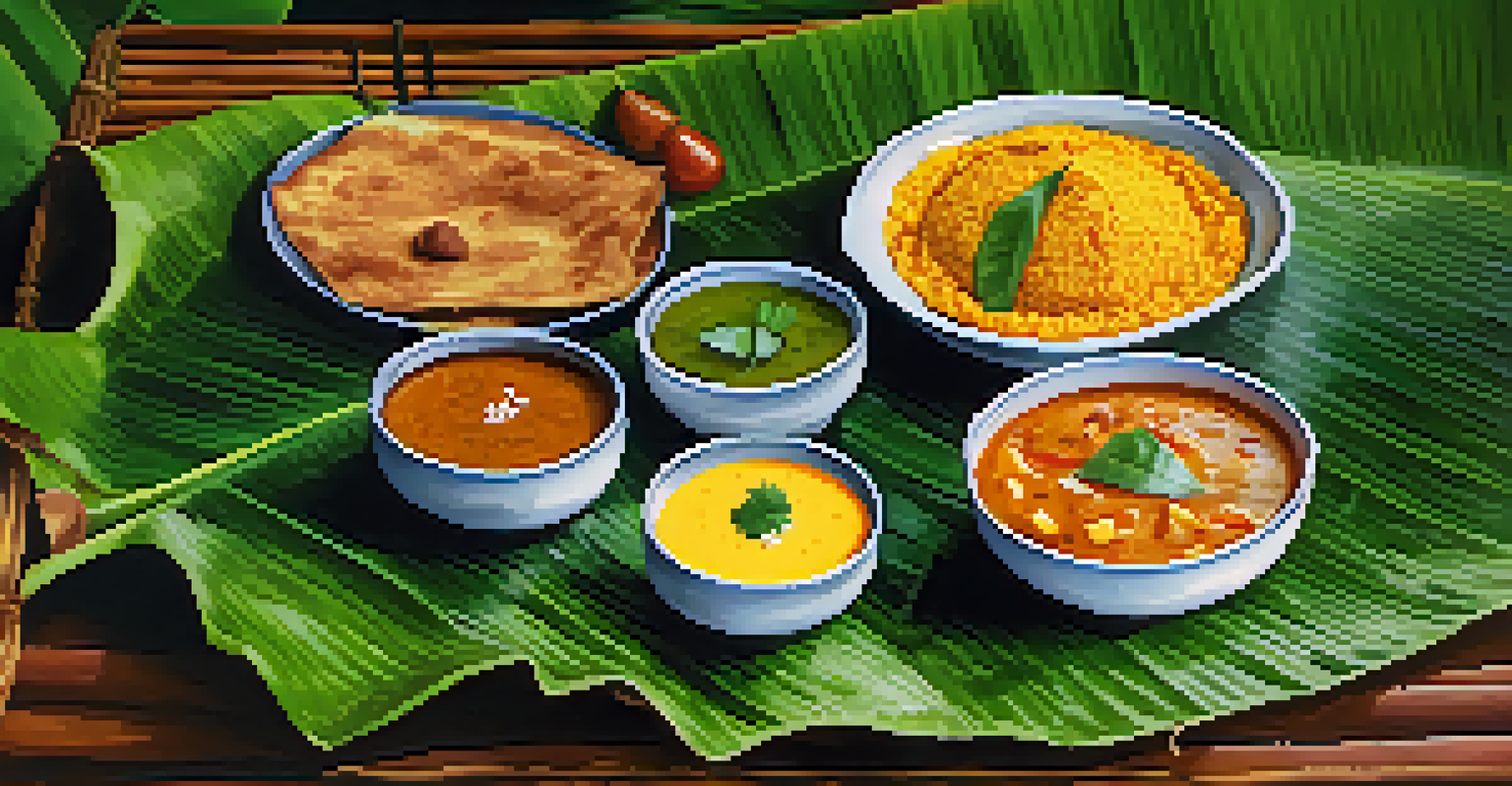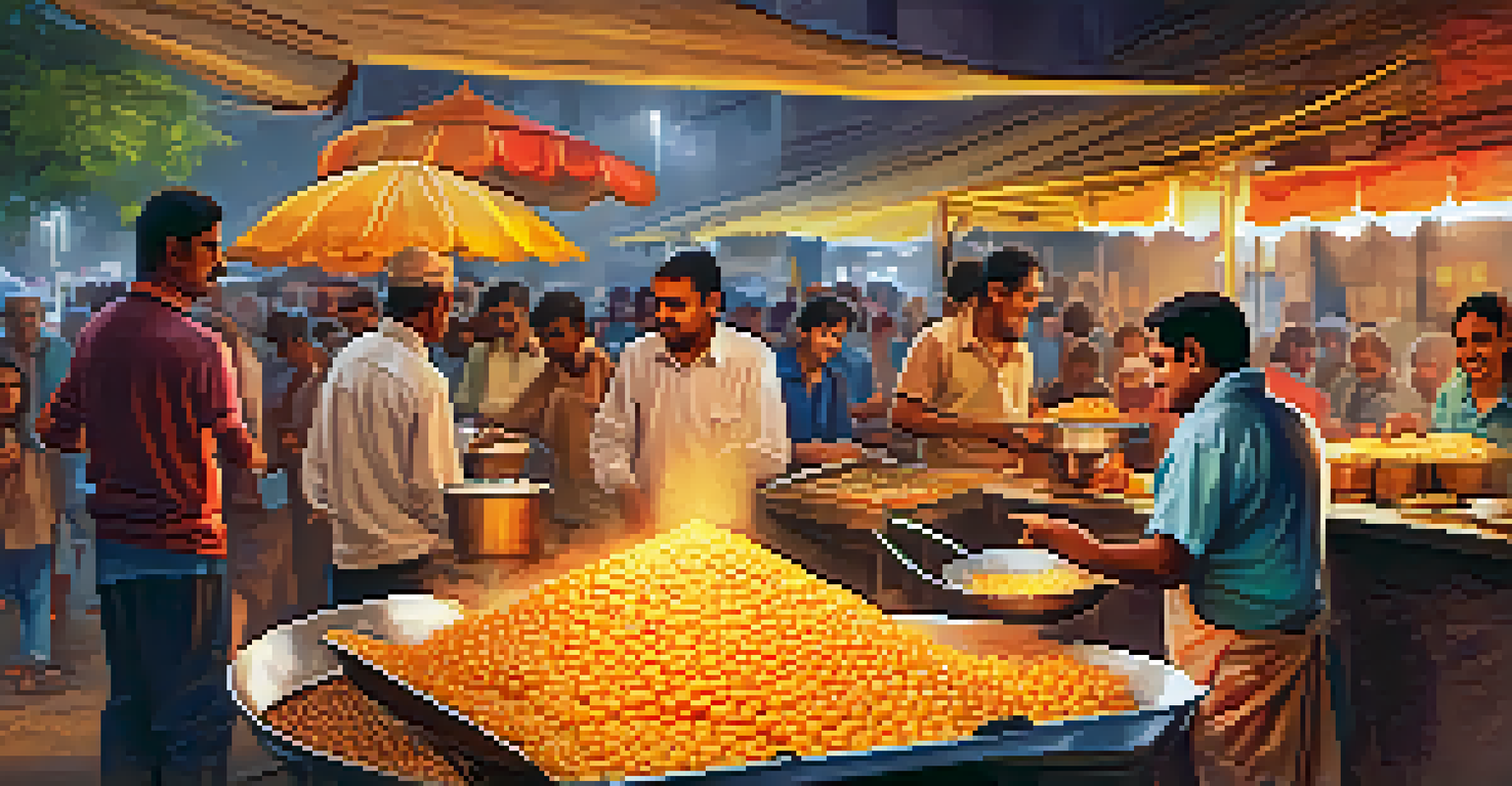Flavors of India: The Ultimate Guide to Regional Cuisines

The Spice Bazaar: Understanding Indian Spices
India is renowned for its vibrant and diverse array of spices, often considered the backbone of Indian cuisine. Spices like cumin, coriander, and turmeric not only elevate flavors but also provide numerous health benefits. Each region utilizes spices differently, creating unique flavor profiles that reflect local traditions and ingredients.
Spices are the essence of life, adding flavor and depth to our experiences.
For example, the use of mustard seeds is prevalent in Bengali dishes, while Kashmiri cuisine favors the rich flavor of saffron. Understanding these nuances helps in appreciating the culinary diversity across India. By mastering the art of using spices, home cooks can recreate authentic Indian dishes that burst with flavor.
Thus, exploring Indian spices is not just about taste, but also about cultural significance, as many spices hold historical importance and are integral to festivals and rituals.
North India: A Rich Tapestry of Flavors
North Indian cuisine is often characterized by its hearty and rich dishes, with staples like naan, paneer, and biryani taking center stage. The region's climate and agricultural practices influence the use of dairy products and wheat, resulting in creamy gravies and robust flavors. Dishes like butter chicken and chole bhature exemplify this richness, often enjoyed with an array of pickles and chutneys.

Street food is also a major highlight in North India, with classics like golgappa and aloo tikki drawing locals and tourists alike. Each dish tells a story, reflecting the culture and history of the region. The bustling markets filled with fragrant food stalls are a testament to the vibrant culinary scene here.
Diverse Flavors Across India
Each region of India offers unique culinary experiences, showcasing distinct ingredients and cooking techniques that reflect local traditions.
Moreover, festivals in North India often feature elaborate feasts, showcasing the region's diverse culinary heritage. From Diwali sweets to Eid biryanis, the celebratory aspect of food is deeply ingrained in the culture.
South India: A Symphony of Flavors and Textures
In South India, cuisine is a delightful mix of rice, lentils, and fresh vegetables, often accompanied by coconut and tamarind. Dishes like dosa and sambar highlight the region's love for fermentation and cooking techniques that enhance flavor and nutrition. Each meal is a balance of tastes, with a focus on light, spicy, and tangy elements that awaken the palate.
Food is not just what we eat; it is a reflection of our culture and identity.
Breakfast is especially important, and items like idli and upma are popular choices that reflect the region’s diversity. Moreover, the use of aromatic spices such as curry leaves and mustard seeds adds a unique character to every dish. A traditional South Indian meal served on a banana leaf is not just food; it’s an experience steeped in tradition.
The regional variations are vast, from the seafood-rich dishes of Kerala to the fiery flavors of Andhra Pradesh. Each area tells its own story through its culinary practices, making South Indian cuisine a rich tapestry of flavors.
East India: Sweetness and Seafood Unite
East India is a treasure trove of culinary delights, where sweet and savory flavors coexist harmoniously. Famous for its desserts like rasgulla and sandesh, the region showcases its love for sweets, often made with fresh chhena (cottage cheese). The use of fish is predominant in Bengali cuisine, where mustard oil and spices create aromatic dishes like macher jhol.
Rice is a staple, serving as the foundation for many meals, and is often paired with lentils and a variety of vegetables. The culinary practices here are heavily influenced by the surrounding waterways, leading to a rich tradition of seafood dishes. Festivals often feature elaborate meals that highlight the region's culinary prowess.
Cultural Significance of Food
Indian cuisine is deeply intertwined with cultural rituals and festivals, making food a vital part of social interaction and heritage.
Additionally, the cultural significance of food in East India is profound, with dishes often prepared for rituals and celebrations, adding layers of meaning to every meal. It's a region where food becomes a medium of storytelling, reflecting its rich heritage.
West India: A Culinary Journey of Spice and Sweet
West Indian cuisine is a vibrant mix of spices, flavors, and ingredients, reflecting its diverse cultural influences. From the spicy curries of Gujarat to the coastal delicacies of Maharashtra, this region showcases an incredible variety of dishes. The use of jaggery in many recipes adds a unique sweetness that balances out the heat from spices, creating a delightful contrast.
Street food is an integral part of West Indian cuisine, with famous snacks like vada pav and pav bhaji drawing crowds at roadside stalls. Each dish is a celebration of local ingredients, often prepared with love and tradition. The unique flavors of this region stem not only from spices but also from the cooking methods passed down through generations.
Moreover, festivals in West India are a feast for the senses, featuring a wide array of sweets and savory dishes that highlight the culinary diversity. From Diwali’s festive treats to the vibrant flavors of Ganesh Chaturthi, the region’s love for food is palpable.
Northeast India: A Hidden Gem of Flavors
Exploring the cuisine of Northeast India is like uncovering a hidden gem, with its unique flavors and ingredients often overlooked by mainstream Indian cooking. The region boasts a variety of dishes made from rice, meats, and fresh vegetables, often seasoned with herbs and fermented items. Dishes like bamboo shoot curry and fish wrapped in banana leaves reflect the indigenous cooking techniques and local ingredients.
Unlike other regions, the use of spices is more subtle, allowing the natural flavors of the ingredients to shine. The emphasis on freshness and simplicity makes the food light yet satisfying. The region’s diverse tribes contribute to the culinary landscape, each bringing their own traditional dishes and cooking styles.
Global Influence of Indian Cuisine
Indian flavors have gained worldwide popularity, with chefs and home cooks embracing spices and dishes that enhance global culinary diversity.
Additionally, the communal aspect of meals in Northeast India highlights the culture of sharing and togetherness. Food is often enjoyed during festivals and gatherings, cementing its role as a cornerstone of social interaction.
The Influence of Indian Cuisine Globally
Indian cuisine has made its mark on the global culinary scene, with flavors and dishes transcending borders. From curry houses in the UK to Indian restaurants in the US, the popularity of Indian food has soared in recent years. The diverse flavors and vegetarian-friendly options appeal to a wide audience, making it a favorite among food lovers worldwide.
Moreover, Indian spices are now staples in many international kitchens, adding warmth and richness to various cuisines. Chefs and home cooks alike are experimenting with Indian flavors, incorporating ingredients like garam masala and turmeric into their recipes. This fusion of flavors is creating exciting new dishes that pay homage to traditional Indian cooking.

Culinary festivals and cooking classes around the world help bridge cultural gaps, allowing people to experience the richness of Indian cuisine firsthand. Through food, we can foster understanding and appreciation for different cultures, making Indian cuisine a vital part of the global culinary landscape.
Embracing Indian Cuisine at Home
Bringing the flavors of India into your kitchen can be an exciting culinary adventure. With a treasure trove of recipes available online and in cookbooks, anyone can explore Indian cooking at home. Start with simple dishes, like a basic dal or a vegetable curry, to get a feel for the spices and cooking techniques used in Indian cuisine.
Experimenting with spices is key to unlocking the authentic flavors of Indian dishes. Invest in a few essential spices such as cumin, coriander, and turmeric, and learn how to balance them in your cooking. Remember, cooking is an art, and practice will help you master the nuances of flavor and seasoning.
Moreover, sharing your culinary creations with family and friends can make the experience even more enjoyable. Hosting an Indian-themed dinner night is a great way to introduce others to this rich culinary heritage and create lasting memories around the table.